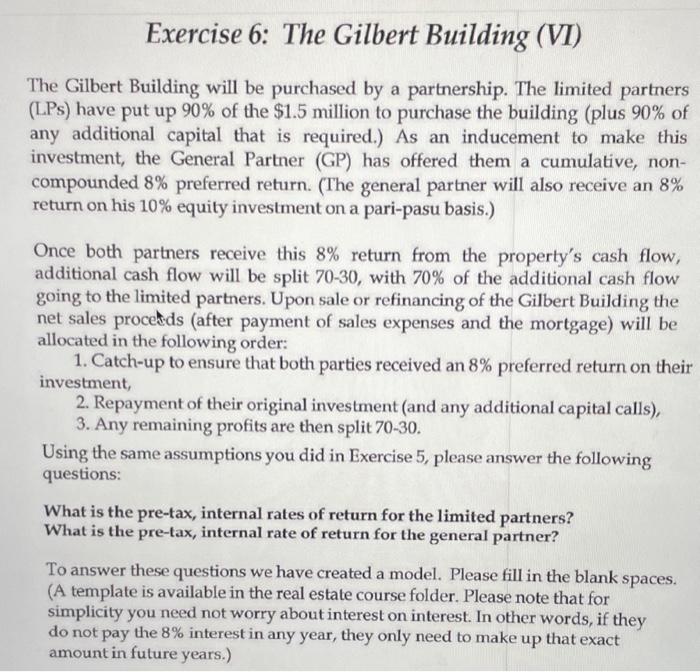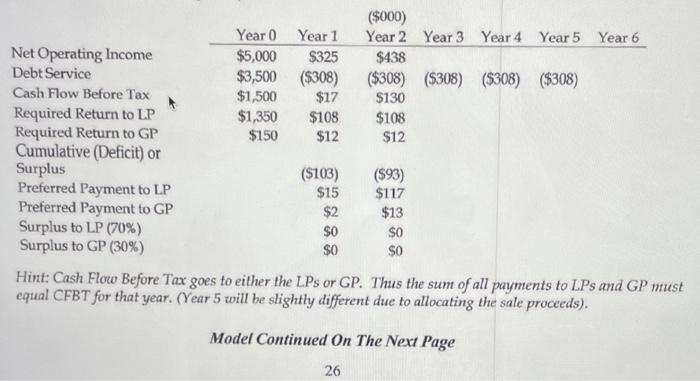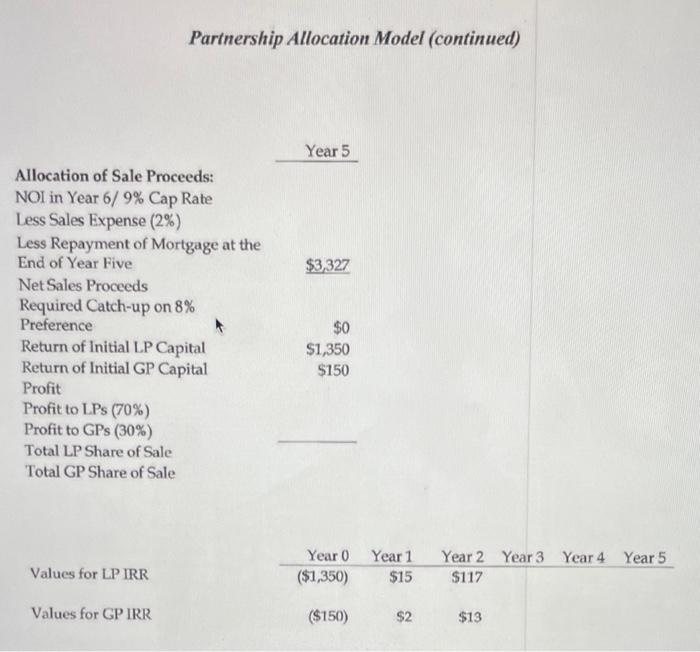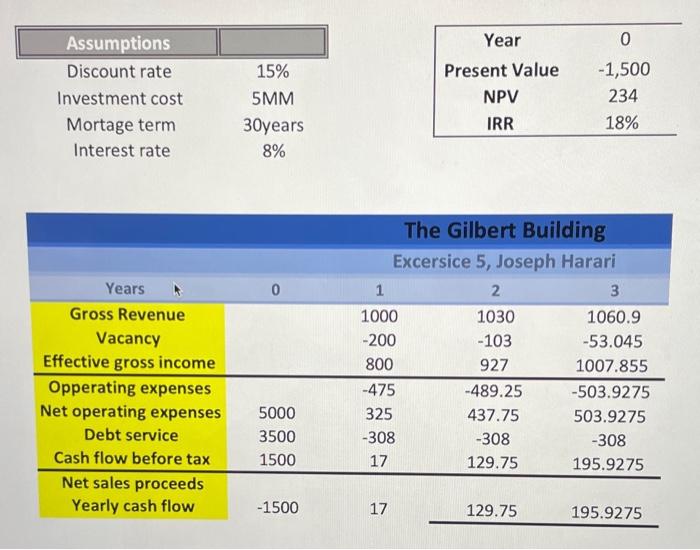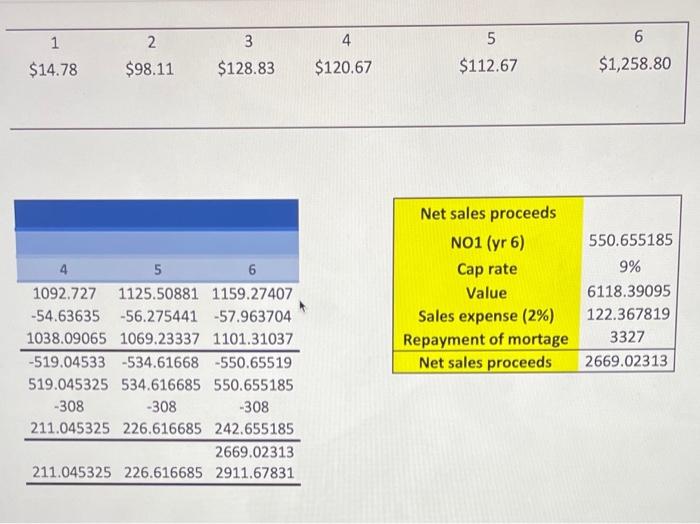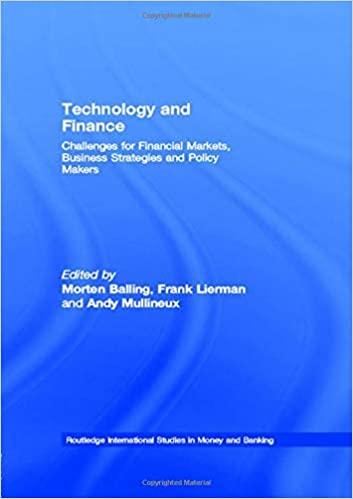REAL ESTARE QUESTION
PLEASE:
ANSWER IN EXCEL
AND SEND ME PICTURE
THANKS.
The Gilbert Building will be purchased by a partnership. The limited partners (LPs) have put up 90% of the $1.5 million to purchase the building (plus 90% of any additional capital that is required.) As an inducement to make this investment, the General Partner (GP) has offered them a cumulative, noncompounded 8% preferred return. (The general partner will also receive an 8% return on his 10% equity investment on a pari-pasu basis.) Once both partners receive this 8% return from the property's cash flow, additional cash flow will be split 7030, with 70% of the additional cash flow going to the limited partners. Upon sale or refinancing of the Gilbert Building the net sales procetds (after payment of sales expenses and the mortgage) will be allocated in the following order: 1. Catch-up to ensure that both parties received an 8% preferred return on their investment, 2. Repayment of their original investment (and any additional capital calls), 3. Any remaining profits are then split 70-30. Using the same assumptions you did in Exercise 5, please answer the following questions: What is the pre-tax, internal rates of return for the limited partners? What is the pre-tax, internal rate of return for the general partner? To answer these questions we have created a model. Please fill in the blank spaces. (A template is available in the real estate course folder. Please note that for simplicity you need not worry about interest on interest. In other words, if they do not pay the 8% interest in any year, they only need to make up that exact amount in future years.) Hint: Cash Flow Before Tax goes to either the LPs or GP. Thus the sum of all payments to LPs and GP must equal CFBT for that year. (Year 5 will be slightly different due to allocating the sale proceeds). Model Continued On The Next Page Partnership Allocation Model (continued) \begin{tabular}{|ccc|} \hline & & \\ \hline 4 & 5 & 6 \\ \hline 1092.727 & 1125.50881 & 1159.27407 \\ 54.63635 & 56.275441 & 57.963704 \\ 1038.09065 & 1069.23337 & 1101.31037 \\ \hline519.04533 & 534.61668 & 550.65519 \\ 519.045325 & 534.616685 & 550.655185 \\ 308 & 308 & 308 \\ 211.045325 & 226.616685 & 242.655185 \\ \hline & & 2669.02313 \\ 211.045325 & 226.616685 & 2911.67831 \\ \hline \end{tabular} The Gilbert Building will be purchased by a partnership. The limited partners (LPs) have put up 90% of the $1.5 million to purchase the building (plus 90% of any additional capital that is required.) As an inducement to make this investment, the General Partner (GP) has offered them a cumulative, noncompounded 8% preferred return. (The general partner will also receive an 8% return on his 10% equity investment on a pari-pasu basis.) Once both partners receive this 8% return from the property's cash flow, additional cash flow will be split 7030, with 70% of the additional cash flow going to the limited partners. Upon sale or refinancing of the Gilbert Building the net sales procetds (after payment of sales expenses and the mortgage) will be allocated in the following order: 1. Catch-up to ensure that both parties received an 8% preferred return on their investment, 2. Repayment of their original investment (and any additional capital calls), 3. Any remaining profits are then split 70-30. Using the same assumptions you did in Exercise 5, please answer the following questions: What is the pre-tax, internal rates of return for the limited partners? What is the pre-tax, internal rate of return for the general partner? To answer these questions we have created a model. Please fill in the blank spaces. (A template is available in the real estate course folder. Please note that for simplicity you need not worry about interest on interest. In other words, if they do not pay the 8% interest in any year, they only need to make up that exact amount in future years.) Hint: Cash Flow Before Tax goes to either the LPs or GP. Thus the sum of all payments to LPs and GP must equal CFBT for that year. (Year 5 will be slightly different due to allocating the sale proceeds). Model Continued On The Next Page Partnership Allocation Model (continued) \begin{tabular}{|ccc|} \hline & & \\ \hline 4 & 5 & 6 \\ \hline 1092.727 & 1125.50881 & 1159.27407 \\ 54.63635 & 56.275441 & 57.963704 \\ 1038.09065 & 1069.23337 & 1101.31037 \\ \hline519.04533 & 534.61668 & 550.65519 \\ 519.045325 & 534.616685 & 550.655185 \\ 308 & 308 & 308 \\ 211.045325 & 226.616685 & 242.655185 \\ \hline & & 2669.02313 \\ 211.045325 & 226.616685 & 2911.67831 \\ \hline \end{tabular}
